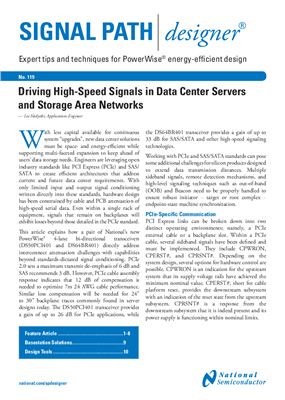10 страниц.
Статья по применению продукции National Semiconductor.
SIGNAL PATH designer No.119.
With less capital available for continuous system upgrades, new data center solutions
must be space- and energy-effi cient while supporting multi-faceted expansion to keep ahead of
users’ data storage needs. Engineers are leveraging open industry standards like PCI Express (PCIe) and SAS/SATA to create effi cient architectures that address current and future data center requirements. With only limited input and output signal conditioning written directly into these standards, hardware design has been constrained by cable and PCB attenuation of high-speed serial data. Even within a single rack of equipment, signals that remain on backplanes will exhibit losses beyond those detailed in the PCIe standard.
This article explains how a pair of National’s new PowerWise® 4-lane bi-directional transceivers (DS50PCI401 and DS64BR401) directly address interconnect attenuation challenges with capabilities beyond standards-dictated signal conditioning. PCIe 2.0 sets a maximum transmit de-emphasis of 6 dB and SAS recommends 3 dB. However, PCIe cable assembly response indicates that 12 dB of compensation is needed to optimize 7m 24 AWG cable performance. Similar loss compensation will be needed for 24 to 30 backplane traces commonly found in server designs today. The DS50PCI401 transceiver provides a gain of up to 26 dB for PCIe applications, while the DS64BR401 transceiver provides a gain of up to 33 dB for SAS/SATA and other high-speed signaling technologies.
Working with PCIe and SAS/SATA standards can pose some additional challenges for silicon products designed to extend data transmission distances. Multiple sideband signals, remote detection mechanisms, and high-level signaling techniques such as out-of-band (OOB) and Beacon need to be properly handled to ensure robust initiator – target or root complex – endpoint-state machine synchronization.
Статья по применению продукции National Semiconductor.
SIGNAL PATH designer No.119.
With less capital available for continuous system upgrades, new data center solutions
must be space- and energy-effi cient while supporting multi-faceted expansion to keep ahead of
users’ data storage needs. Engineers are leveraging open industry standards like PCI Express (PCIe) and SAS/SATA to create effi cient architectures that address current and future data center requirements. With only limited input and output signal conditioning written directly into these standards, hardware design has been constrained by cable and PCB attenuation of high-speed serial data. Even within a single rack of equipment, signals that remain on backplanes will exhibit losses beyond those detailed in the PCIe standard.
This article explains how a pair of National’s new PowerWise® 4-lane bi-directional transceivers (DS50PCI401 and DS64BR401) directly address interconnect attenuation challenges with capabilities beyond standards-dictated signal conditioning. PCIe 2.0 sets a maximum transmit de-emphasis of 6 dB and SAS recommends 3 dB. However, PCIe cable assembly response indicates that 12 dB of compensation is needed to optimize 7m 24 AWG cable performance. Similar loss compensation will be needed for 24 to 30 backplane traces commonly found in server designs today. The DS50PCI401 transceiver provides a gain of up to 26 dB for PCIe applications, while the DS64BR401 transceiver provides a gain of up to 33 dB for SAS/SATA and other high-speed signaling technologies.
Working with PCIe and SAS/SATA standards can pose some additional challenges for silicon products designed to extend data transmission distances. Multiple sideband signals, remote detection mechanisms, and high-level signaling techniques such as out-of-band (OOB) and Beacon need to be properly handled to ensure robust initiator – target or root complex – endpoint-state machine synchronization.

